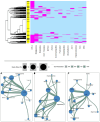Epidemiology of the COVID-19 pneumonia in a group of hospitals from Madrid-Spain during the full period of the State of Alarm HM cohort
- PMID: 39950446
- PMCID: PMC11894567
- DOI: 10.37201/req/110.2024
Epidemiology of the COVID-19 pneumonia in a group of hospitals from Madrid-Spain during the full period of the State of Alarm HM cohort
Abstract
Introduction: To describe the epidemiology pattern of the COVID-19 pandemic during all Spanish State of Alarm.
Methods: Retrospective, observational, cohort and multicenter study. Inclusion criteria: age ≥18 years old, admitted for COVID-19 pneumonia in any of the centers of the HM Hospitals Group. Exclusion criteria: voluntary discharge, death in the emergency department, transfer to centers outside the HM group or incomplete data. State of Alarm period: 31/01/2020 to 05/07/2023. Predominant COVID-19 variant was defined when it exceeded 50% of the total isolates.
Results: During the study period, 2,992 patients were admitted due to a COVID-19 pneumonia, 295 patients (9.86%) non-survive. Survivors and non-survivors were different in age and comorbidities. However, both cohorts presented a similar net of interaction between comorbidities. Hospital admissions per week showed an evolution in "peaks" with "troughs". A total of 197 (6.48%) patients were admitted to the ICU, of whom 52 (26.39%) non-survive; this subgroup stood out for having a higher proportion of septic shock, orotracheal intubation and acute renal failure, as well as a lower proportion of pulmonary thromboembolism and delirium. Concerning the viral variants, the incidence for the original variant was 4.05 cases/day, for the alpha variant 3.82 cases/day, for the delta variant 1.16 cases/day and for the omicron variant 1.35 cases/day.
Conclusion: Almost 1 of 10 patients with COVID-19 pneumonia death, a proportion that increased to 1 of 4 in case of being admitted to the ICU. Unexpectedly, interaction between comorbidities did not differ between survivors and non-survivors patients. Predominant variants were associated with different hospital admission rates but not influence the presence of peak-troughs evolution of the pandemic.
Introducción: Describir el patrón epidemiológico de la pandemia de COVID-19 durante todo el estado de alarma en España.
Métodos: Estudio retrospectivo, observacional, de cohorte y multicéntrico. Criterios de inclusión: edad ≥18 años, ingreso por neumonía COVID-19 en cualquiera de los centros del Grupo de Hospitales HM. Criterios de exclusión: alta voluntaria, fallecimiento en el servicio de urgencias, traslado a centros fuera del grupo HM o datos incompletos. Estado de alarma: del 31/01/2020 al 05/07/2023. Se definió como variante predominante de COVID-19 aquella que superó el 50% de los aislamientos totales.
Resultados: Durante el período de estudio, se admitieron 2.992 pacientes por neumonía COVID-19, de los cuales 295 pacientes (9,86%) no sobrevivieron. Los sobrevivientes y no sobrevivientes mostraron diferencias en edad y comorbilidades. Sin embargo, ambas cohortes presentaron una red de interacción similar entre las comorbilidades. Los ingresos hospitalarios por semana mostraron una evolución en “picos” y “valles”. Un total de 197 pacientes (6,48%) fueron admitidos en la UCI, de los cuales 52 (26,39%) no sobrevivieron; este subgrupo se caracterizó por una mayor proporción de shock séptico, intubación orotraqueal e insuficiencia renal aguda, así como una menor proporción de tromboembolismo pulmonar y delirio. En relación con las variantes virales, la incidencia fue de 4,05 casos/día para la variante original, 3,82 casos/día para la variante alfa, 1,16 casos/día para la variante delta y 1,35 casos/día para la variante ómicron.
Conclusiones: Casi 1 de cada 10 pacientes con neumonía por COVID-19 falleció, proporción que aumentó a 1 de cada 4 en caso de ingreso en la UCI. De manera inesperada, la interacción entre comorbilidades no difería entre pacientes sobrevivientes y no sobrevivientes. Las variantes predominantes se asociaron a diferentes tasas de ingreso hospitalario, pero no influyeron en la evolución de picos y valles de la pandemia.
Keywords: COVID-19; Epidemiology; Health crisis; Pandemia; Pneumonia; SARS-CoV-2; VOCs variants.
© 2025 Sociedad Española de Quimioterapia. Este es un artículo open access bajo la licencia CC BY-NC 4.0.
Conflict of interest statement
The authors declare that they have no conflicts of interest.
Figures


References
-
- España MdSd . Actualización n° 672. Enfermedad por el coronavirus (COVID-19). 30.06.2023 2023. [26-7-2024]. Available from: https://www.sanidad.gob.es/areas/alertasEmergenciasSanitarias/alertasAct....
-
- Drago G, Perez-Sadaba FJ, Aceituno S, Gari C, Lopez-Belmonte JL. Healthcare resource use and associated costs in a cohort of hospitalized COVID-19 patients in Spain: A retrospective analysis from the first to the third pandemic wave. EPICOV study. PLoS One. 2023;18(1):e0280940. doi: 10.1371/journal.pone.0280940. - DOI - PMC - PubMed
-
- España MdS-. Actualización de la situación epidemiológica de las variantes deSARS-CoV-2 en España 2023 [28/7/2024]. Available from: https://www.sanidad.gob.es/profesionales/saludPublica/ccayes/alertasActu....
Publication types
MeSH terms
Supplementary concepts
LinkOut - more resources
Full Text Sources
Medical
Miscellaneous

